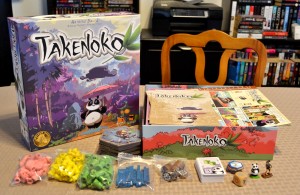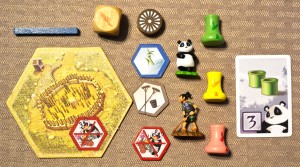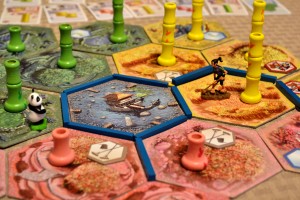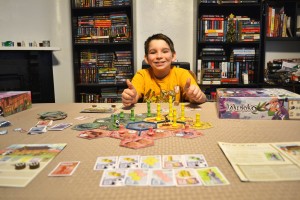I seriously have yet to meet anyone who doesn’t find pandas to be the cutest thing on this planet…that is, except maybe for those who have said no to “Panda Cheese”. “Takenoko” (which means, Bamboo Sprout) puts players in the role of courtesans who must not only feed the emperor’s panda, but manage an ever-growing bamboo plantation. Players earn points for satisfying the emperor’s requests, as well as for feeding the panda and catering to the wishes of the gardener. Will you assist the gardener in growing specific patterns of bamboo, or will you just let the panda devour it all? The choice is yours…though my money’s on the panda.
Components
Plots – These hexagonal tiles of varying colors (green, yellow, and pink) serve as the “board” in which the bamboo will grow.
Bamboo Sections – These pieces come in either green, yellow, or pink and represent that bamboo that will be growing on the plot tiles.
Irrigation Channels – These blue sticks (similar to those found in “Santiago”) will irrigate the plot tiles that they are adjacent to.
Improvements – These small tokens can be placed onto plots to facilitate the growth of bamboo. Some plots already contain improvements, while others can be upgraded via these improvement tokens.
Objective Cards – Players will be attempting to satisfy objectives to earn points via these plot, panda, and gardener objective cards.
Individual Boards & Action Chips – Players will organize their turn by utilizing their individual player boards and action chips.
Weather Die – Each turn, players will be rolling this die to change the weather. Each weather type allows the player to make use of some type of special action.
Gardener & Panda Figurine – Players will be moving both of these figurines around the board (plots) to perform certain actions.
Setup & Gameplay
The special pond tile is placed in the center of the table, with the gardener and panda figurines placed directly on top of it. The plot tiles are shuffled face down into a stack. The rest of the components (irrigation channels, improvements, the emperor card, objective cards, etc.) are separated into their own respective piles and shuffled if appropriate. Each player receives a player board, two action tokens, and one of each objective card (total of three) to form their starting hand.
Editor’s Note: While not supported by the manual, irrigation channels can be placed around the pond to serve as a visual cue (the pond already irrigates surrounding tiles by default), though this is optional.
On a player’s turn, the following will occur:
1) Determine the Weather – In every round except for the first, a weather die will be rolled at the beginning of every player’s turn. This will result in some type of special action in which the current player can make use.
2) Take Two Actions – The player may take two of the five following actions (they must be different):
A) Draw Plot – The player draws three plots, chooses one to place adjacent to another plot, and puts the other two back into the face down stack. If the new tile is irrigated, it grows a piece of bamboo.
B) Keep/Place Irrigation Channel – The player takes an irrigation channel. He/She may place it immediately or keep it for a future turn.
C) Move Gardner – The player will move the gardener in a straight line until they reach the desired space. Once there, the gardener will water that tile and all irrigated, adjacent tiles of the same color, causing one bamboo of that color to grow.
D) Move Panda – The player will move the panda in a straight line until they reach the desired space. The panda eats one of the bamboo pieces there, which goes onto the player’s board.
E) Draw Objective Card – The player can draw one objective card from any of the three objective decks.
At any time during this phase, the player can complete objective cards by placing them face up in front of them.
Turns will continue until one player manages to complete a particular number of objectives, who then triggers the final round. That player receives the emperor card (worth two points). After everyone else takes one last turn, scores are compared (via the completed objective cards) and the person with the most points, wins the game!
The above doesn’t cover all of the rules found in the manual, but should give you the general idea as to how gameplay flows. Feel free to leave a comment if you have questions.
The Review
Highly thematic doesn’t begin to describe “Takenoko”. The kids and I were simply blown away by the look and feel of the components. Of course, the panda figurine was the star of the show and even attracted the fourteen year old, Carolyn, to come over to the table. The rules were laid out well and the player boards really helped to keep everyone organized. There was a little bit of a learning curve, though most of it seemed to revolve around what a player could (and most probably should) do at any point in time…having a lot of options served to confuse the youngest a bit, but he quickly got the hang of things.
Along those same lines, there is a ton of strategy to consider while playing. Having three different ways to score points (via the three objective card types) really affects the way the game can play out, as not everyone will always be going after the same objectives as you. The gardener objectives, for example, task players with growing bamboo so many spaces high on a cluster of plots. The panda objectives, on the other hand, encourage players to eat said bamboo. These conflicting objectives can set players back a bit if they end up fighting over a particular area. The plot objective cards simply task players with building plots in a certain color scheme and shape, so that particular objective type is a tad less conflicting. Some colors are more rare than others too, so there’s that to consider as they appear during the game.
There’s also a little bit of randomness going on at the same time, though I wouldn’t consider that a bad thing in this case. Players are limited to strategies based on the objective cards they draw. If they draw gardener objective cards that all point to a particular color, for example, they’ll be forced to focus on that or run the risk of not scoring anything at the game’s end. The weather die further adds to the chaos, granting some type of random ability or action. To be fair, I did find the action useful most of the time, no matter what I happened to roll. If I rolled a storm and wasn’t focusing on devouring bamboo, I could instead play the panda offensively and devour bamboo I knew that other players were trying to build up to satisfy a gardener objective.
Overall, the kids and I really enjoyed playing “Takenoko”. It’s got just enough of a learning curve to be interesting, but is easy enough for younger kids to get the hang of with the assistance of an adult. There’s a lot of strategic depth in “Takenoko”, so there’s no shortage of thinking required in order to pull ahead of the competition. The fact that the game is pretty and well themed is just icing on the cake. I highly recommend this game to both families and hardcore gamers alike. “Takenoko” is easily one of my favorite games of all time.
Final Verdict: 10/10
—




